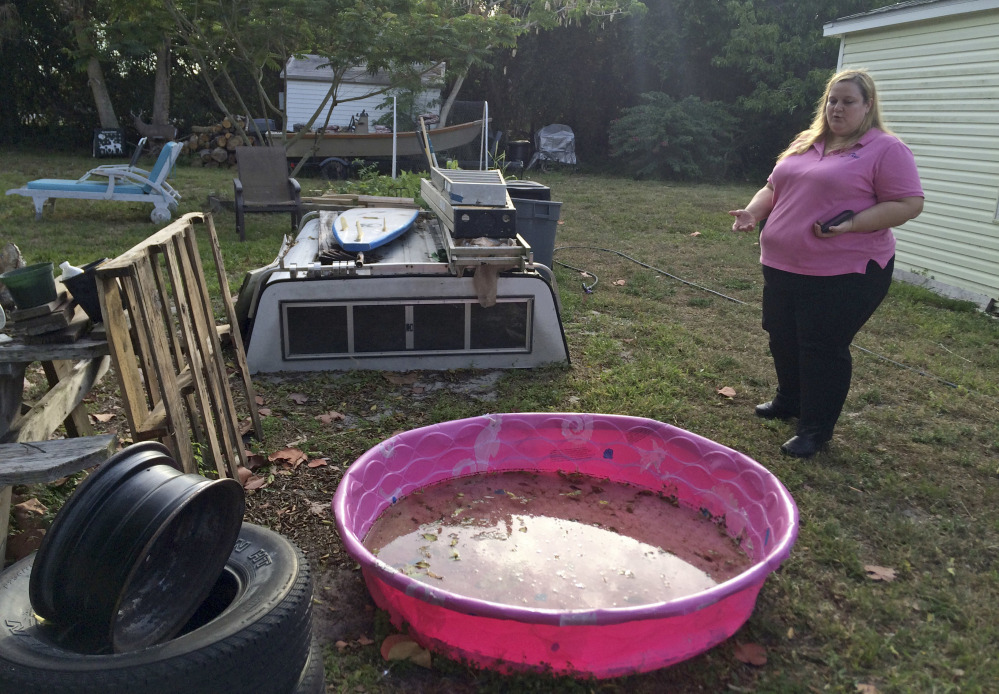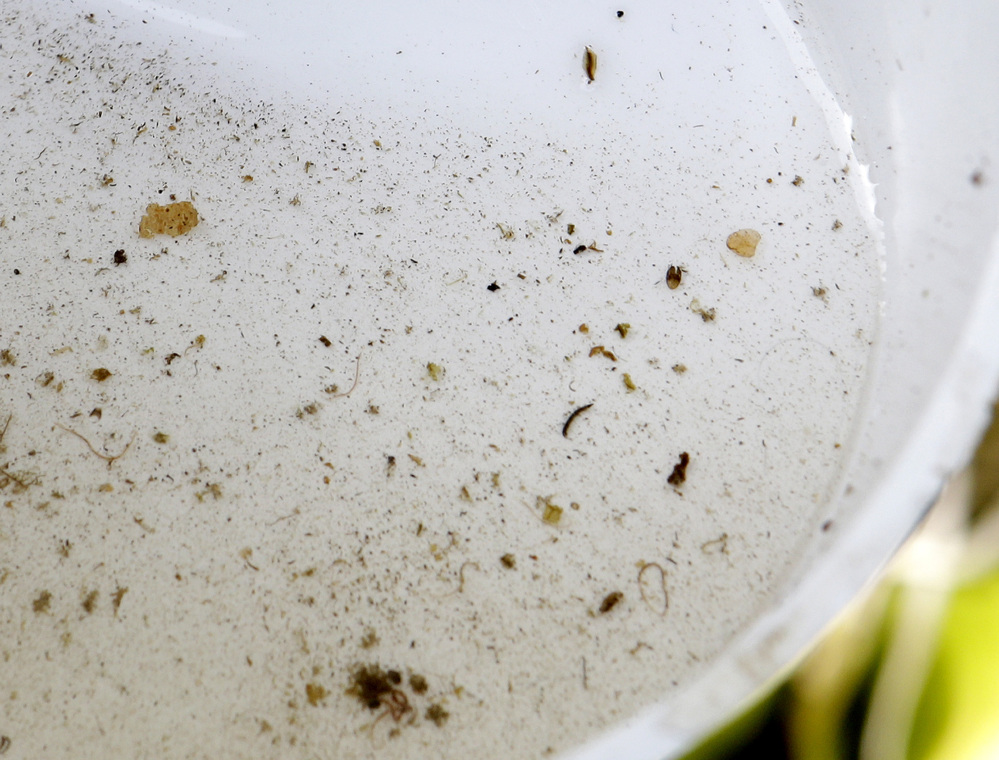RIO, Fla. – A summer flu seemed to be sweeping through Rachel Heid’s riverfront neighborhood. Pale and shaky, she left work with a fever. Neighbors had the same symptoms, and a contractor at her home felt so sick he went to the hospital.
Heid thought the neighborhood children were passing a bug around their circle. She never suspected a virus carried by bugs hovering around their birdbaths and tarp-covered boats – until health officials left pamphlets at their houses asking for blood samples if they recently suffered from fevers and joint or muscle pain.
The dengue fever outbreak infected 28 people in August and September 2013. It caught Florida’s Atlantic coast by surprise. The mosquito-borne disease associated with crowded, third-world conditions had spread among the pink plastic flamingoes of Rio (pronounced RYE-oh) and Jensen Beach.
The mosquitoes that spread dengue also carry the Zika virus, which has been linked to serious birth defects and has grown into an epidemic in Central and Latin America – though officials expect only small outbreaks in the United States. The successful fight against dengue in these Florida suburbs may forecast what other U.S. communities worried about Zika face as the summer mosquito season begins. Among the lessons local officials learned: the importance of home inspections by mosquito control technicians, media campaigns to “drain and cover” standing water, and changes residents made in their own yards.
Travelers occasionally come home with dengue, but Florida went 75 years without a local infection until a 2009 outbreak in Key West. The state now records a handful of cases annually, mostly in the densely populated Miami area. Health officials have alerted hospitals to the potential for dengue, but mosquito-borne diseases have rarely worried lifelong Florida residents like Heid.
“We don’t have an international airport here. We don’t have a lot of tourism. We don’t have a cruise, we don’t have a port – nothing. So we don’t have the international intake like you would in Miami or the Keys. But yet – we had dengue here,” Heid said.
The 2013 outbreak in Martin County seemed like an anomaly – 100 miles north of Miami, in communities with fewer than 15,000 people – but it had the Aedes aegypti mosquitoes that transmit dengue and a traveler who brought home the virus two years earlier.
The last time Heid had thought of mosquitoes as more than pests was in 1990, during a statewide outbreak of mosquito-borne St. Louis encephalitis. Her Martin County high school started playing afternoon football games to avoid bugs biting at dusk, and she remembers the smell of insecticides wafting over as mosquito control trucks passed by.
“When I was a kid, when they would fog, it was heavy,” she said. “It smelled like a can of Raid.”
She noticed there were fewer chemicals deployed in 2013.
Fogging trucks rumbled down the streets of affected neighborhoods nearly every night for a month, but county employees spent more time – four or five hours daily – on sweeps targeting all small containers holding water where Aedes aegypti breed. The biggest offenders: buckets, kiddie pools, recycling bins, convenience-store soda cups, potato chip bags and boats.
“Rio is this old seaside town, you know, a fishing town,” said Stephen Noe, a county mosquito control inspector. “Boats were a huge problem.”
Maintenance and office workers from the county engineering department joined Noe and five other mosquito control employees for the work. The response drew resources away from mosquito surveillance elsewhere in the county, but for an operation with a budget under $1 million dollars and only six employees, it was enough to handle the outbreak, said Don Donaldson, the county’s engineering director.
Eight people needed hospitalization, but none suffered more severe forms of dengue. Things could have been worse, hospital officials said.
Caught off-guard by the outbreak, blood banks suspended collections in two counties. Officials later determined that was overkill and could have jeopardized a third of Florida’s blood supply if dengue had struck a larger county, said OneBlood’s chief medical officer, Dr. Rita Reik. New protocols suspend donations only from the ZIP codes immediately affected by mosquito-borne viruses.
Today, all but a handful of hotspots in the outbreak areas remain mostly clear of the discarded containers that attract Aedes aegypti, Noe said. “You can’t, you know, eradicate totally, but to go from a dozen houses to just two, even three years later, is great,” he said.
No one has contracted dengue in Martin County since 2013, even though a neighboring county has since documented local transmission of another virus carried by the same mosquito.
Mosquito-borne disease outbreaks develop from a perfect storm of variables, and there’s little evidence supporting the effectiveness of any particular effort to control Aedes aegypti or prevent it from spreading diseases, according to researchers.
“You’ll have to have an infected person arriving into the community, you’ll have to have the vector species in some critical abundance, you’ll need people active outdoors – and you can imagine these things happening every day in Florida. Why in particular did it take hold in that location and it doesn’t take hold in other locations when you have the same exact circumstance?” said Nathan Burkett-Cadena, who studies how mosquitoes transmit viruses at the University of Florida’s medical entomology laboratory.
Mosquito control efforts helped end the 2013 outbreak, but no one can say to what extent, or to what extent similar efforts would prevent or control Zika transmission elsewhere, Burkett-Cadena said.
But people learned something from the dengue outbreak, said Heid, a 39-year-old office manager who now keeps insect repellent by her front door and in her car and adds a capful of bleach when filling a kiddie pool for her dog to cool off.
A few summers ago, she’d be slapping away at mosquitoes while tending to her garden.
“Now it’s not as bad because people emptied their birdbaths,” she said. “They don’t leave standing water. Everyone’s conscious that their garbage can lids are flipped. Even planters that have a catch pan for the water – people are emptying those.”
Send questions/comments to the editors.




Success. Please wait for the page to reload. If the page does not reload within 5 seconds, please refresh the page.
Enter your email and password to access comments.
Hi, to comment on stories you must . This profile is in addition to your subscription and website login.
Already have a commenting profile? .
Invalid username/password.
Please check your email to confirm and complete your registration.
Only subscribers are eligible to post comments. Please subscribe or login first for digital access. Here’s why.
Use the form below to reset your password. When you've submitted your account email, we will send an email with a reset code.